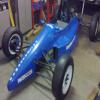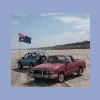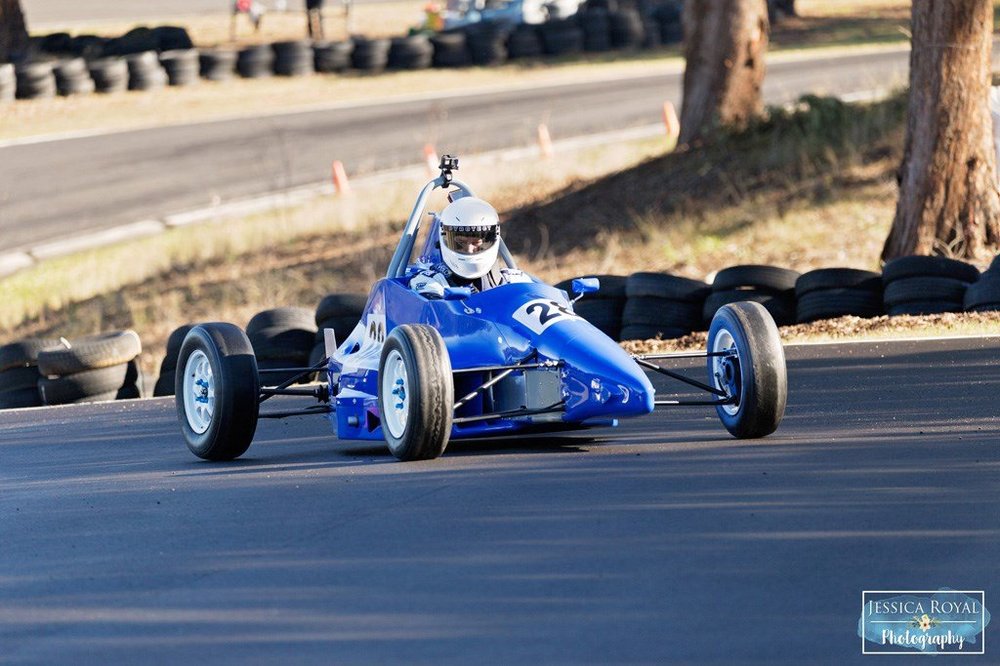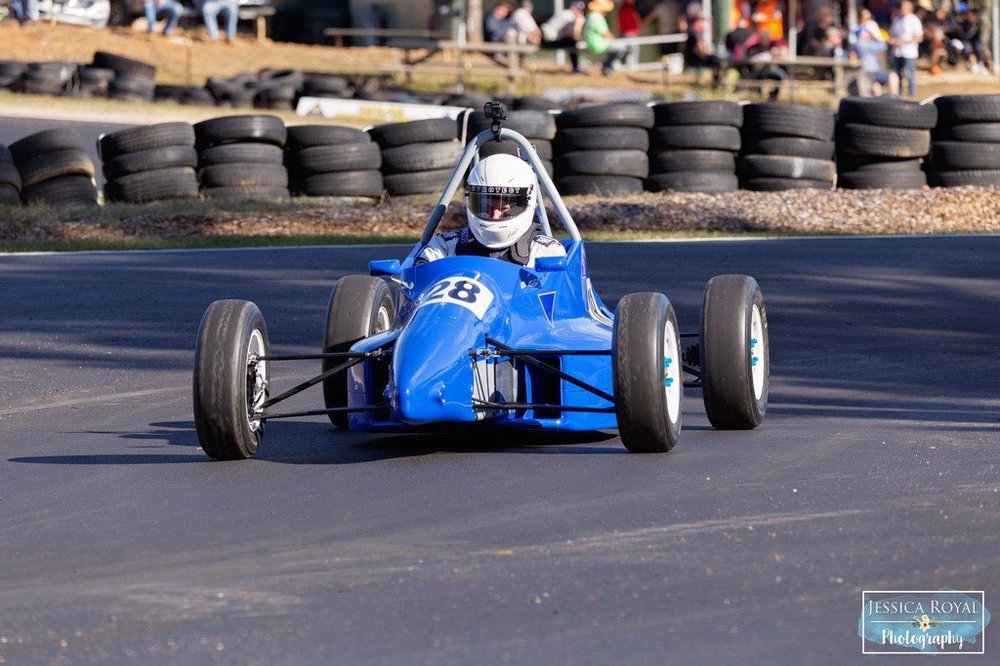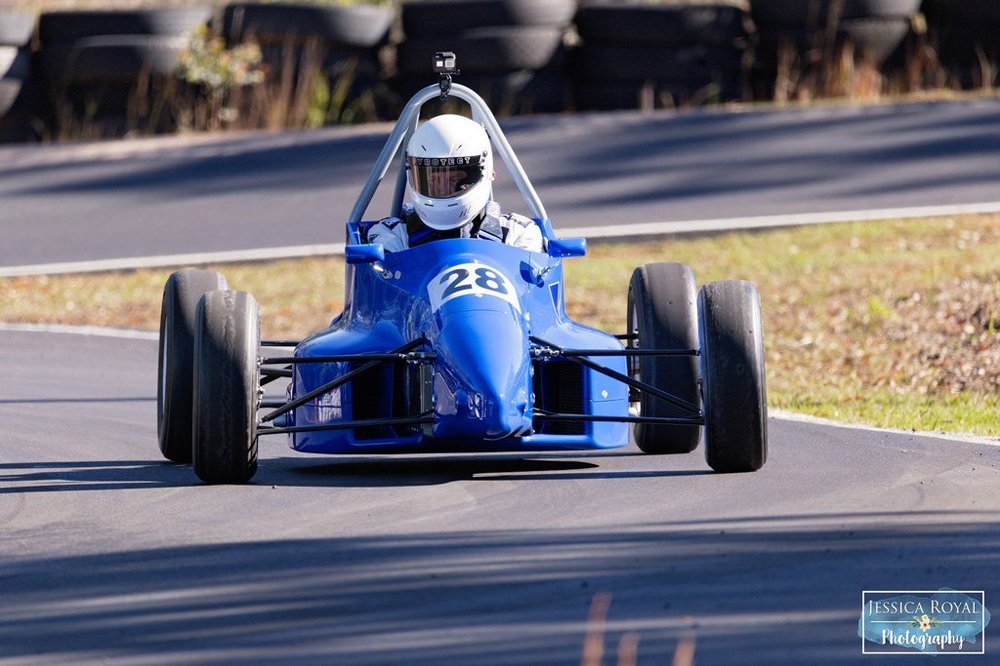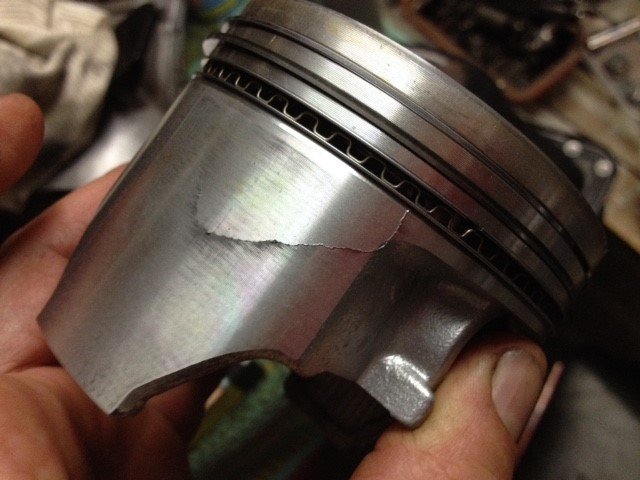-
Posts
41 -
Joined
-
Last visited
About Astro12
- Birthday 06/18/1972
Profile Information
-
Gender
Male
-
Location
NSW Australia
-
Referral
Search - FJ1600
-
Biography
Fitter/Machinist.Enjoy restoring things.
-
Vehicles
FJ1600
Recent Profile Visitors
1021 profile views
Astro12's Achievements

Advanced Member (3/11)
15
Reputation
-
Hi Guys I've finally had the car out at a circuit to do some laps and get used to it. The car felt quite fast, but probably just because I'm not used to it yet. I got about 8 laps in and was starting to really enjoy the ride, pushing a little more each lap,but when I came into the pits the car was making a hell of a racket from the transmission area. I inspected it as best I could, but could not see what the problem was. I figured it was in the transmission and I wasn't about to split the transmission at the track, so I packed up for the 3hr trip home. A bit of a disappointment but that's what happens sometimes when you play with cars. When I got the car home I pulled the car apart and discovered that the flywheel had come loose!! I used RTV to seal the flywheel bolts and torqued them to spec, as they go through the crank flange into the crankcase. Big Mistake. I should have used Loctite. That was only the start of my dilemma, as now the original flywheel bolts were a little bit worse for wear and one had broken off. Originally I thought that the bolts were M9 x 1. Stupid size to make a critical fastener I thought, but no, it gets worse. I have a spare EA 81 engine which had a set of flywheel bolts in it, so I pulled them out and tried fitting them. They are too big. They are actually M9 x 1 but the bolts that came out of the EA 71 crank are about 0.5mm smaller in diameter. Really!!!...…. Mr Subaru, M8.5 x 1!!!! I cant even buy M9 bolts. I'm also having trouble getting an M9 tap. There's not really enough meat in the flywheel flange for M10, for which I could buy decent ARP bolts. So I'm going to continue looking for an M9 tap so I can use the EA 81 bolts. I remember someone saying that Subaru engines are like Lego, ie, you can mix and match parts. From my experience with these engines I find that very far from the truth. Hopefully I can update soon with a bit more of a positive story.
-
Hi Guys, sorry about the long gap in posts. I’ve not had too much to report. My first outing in the car was a bit disappointing really. I turned up to a state championship hillclimb round on a freshly laid surface with 20 year old slicks. I arrived at the track on Friday to setup and Saturday (practice) rained for most of the day so I put the car away after lunch as the track did not even look like drying out. No open wheelers ran in practice but all the sedans were out in the rain and actually doing good times. Sunday dawned quite foggy but no rain yet. By the time drivers briefing was over it was clear that the rain had finally gone away. The track was still wet in most places by the time competition got underway. My first run was way cautious, having never driven the car at all. The track seemed very greasy but I’m sure it was my vintage slicks providing the lack of feel. One other feature of the car which wasn’t helping was the fact that the car is so stiffly sprung that it was picking up a wheel whenever the road twisted, which this circuit does lots over the course of a lap. An open diff also wasn’t helping the situation at all. The engine ran ok, but just didn’t seem happy at times, backfiring through the carb occasionally. I completed all my runs, getting a little bit more game than the run before, and I was just happy getting the car home in one piece. Since that first outing I have had other things taking up my time and money, but I have managed to get the car on a dyno for some tuning and it seems that the original jetting which I had in the car was very close and the only thing which really changed was reduced ignition timing!! I was originally running 15 initial and 35deg total and now it’s at 8 initial and 28 total. I know this will reduce power but the dyno guy reckons 98 octane can only handle 30 total usually. I didn’t have the right jets to do any further tweaking that day so I’ve got some on the way and maybe I can sneak up the timing a little once I have them fitted. So the engine made 90 rwhp, which is certainly not awesome, but just happy that the engine now runs cleanly to 6000rpm. Also discovered that my digital dash tach isn’t working properly and now just relying on a shift light set at 5500. I’m hoping to get the car to a practice day at a circuit more suited to it’s setup in a couple of weeks, where I can do multiple laps in a session to get a bit of a feel for the car. I have to do some more running in this car before the big man in the red suit comes down the chimney!! Astro
-
Had my first outing with the car at a hillclimb event. Went OK but there are some things I need to change and the engine was a bit on the rich side.
-
Bennie, the inspector certainly was happy with what he saw. He even wrote a comment on my application that the car was well constructed and tidy, which he said he doesn't often do but that this car deserved a comment. The fuel pump in the car seemed to be getting lazy the last few times I've started it. The fuel pressure has dropped. The pump in the car is the original one which would be 20+ years old, so not too surprising. I have the replacement pump already so I will fit on the weekend. Got my log book today in the post. Bendigo is where I got the car from. I hope to get to Bathurst at some stage as they run hillclimb events down there so I'll let you know when I'm going. Astro
-
Hi Guys, the car is finally all together and been inspected by CAMS official. Just waiting on my log book now. Need to replace the fuel pump and get it on the dyno for some tuning.
-
Thanks Guys, it's finally coming together after all these years. There is a removable triangular bar on the left side, which allows you to get the engine in sideways. Carb, dizzy and everything else has to be installed when the engine is in the car. It's not the easiest thing to work on, it just takes patience. Fuel cell is installed after engine. The CV's are at a huge angle unfortunately, but that's the way the car was designed and it would be a huge job to change. Maybe in the future if the CV's don't last long. I will definitely be weighing it when finished as I need to set the individual corner weights anyway. I have fired it up, fixed a few leaks and adjusted the timing. The carb is very rich still and sounds a bit fluffy on acceleration. I'm ordering a jet kit tomorrow. I'd post some video, but they are too big a file to post here. Could you suggest an alternative? Astro
-
G'day All, With the engine now finished, it is time to take the bodywork off the car again for fitting the engine. Due to having to take so much off the heads and block, my twin carb manifold does not fit anymore, so I have had to fast track the Weber manifold, which also meant that I had to finish the remote thermostat housing and related plumbing. Radiators were plumbed in and the wiring finalized. Only thing left to do is fill it with fluids and fire it up.
-
Hi Guys, things are progressing well, I have all of my major parts machined, and have the bottom end together. The heads received a huge haircut of 0.071” to achieve a chamber capacity of 30cc. This will give me a 10.8:1 compression ratio. The cam is a little more sensible with 230 degrees duration. I have had to trim and re-profile the valve guides as my new spring retainers are different to the ones I initially measured the clearance with. I also decided to run an exhaust valve stem seal as the original EA engines did not have these. I have had to use a seal which is shorter than the Subaru ones to allow clearance for the valve lift I have. My new valve springs are a beehive style of spring with 10 degree retainers and locks. Spring pads have also been re-machined to suit the springs. I’ve dummy assembled the heads to the block to check pushrod length and rocker geometry and I now know what push rod length I need, but all the shops are closed for Christmas, so I’ll order them as soon as I can. In the process of checking the rocker geometry I realised that the rocker posts were not positively located by any means other than the clamp pressure of the head bolt so I made some hollow stainless steel dowels to locate them. This allowed me to check the alignment of the rockers on the valve tips. Most rockers were in the ballpark but there were a couple that I wanted to move so that the valve has contact in the middle of the rocker pad. This led me to some research online and I came across plenty of information about VW rocker shaft assemblies, which are very similar to the Subaru ones. There are several aftermarket versions available. All of the aftermarket assemblies are made to eliminate the wavy washers and spring clips used on the OEM versions. They instead, precisely shim the rockers and use thick washers and bolts in the end of the rocker shafts to eliminate the spring clips, or (circlips in Subaru case). I have used this information to modify my own assemblies to eliminate any possible failures. The rocker shafts were drilled and tapped each end. I used M6 countersunk screws in one end of the shafts because there is not much room inside the valve cover and M8 at the other, as this is where most of the load comes from the pushrods. The end caps are recessed onto the ends of the shafts to locate them and to eliminate some shims. A potential side benefit is that the rockers might be a lot less noisy than the standard setup. A lot more work but I think this will be very much worth it. I had to make an ignition timing scale bracket, as the original marks had been removed from the flywheel in the process of lightening. A simple bracket was made using a right angle section of aluminium, bolted to the front of the engine near the crankshaft pulley. After modifying the rocker assemblies I realised that there is even less room now than there was under the rockers to tension the head bolts. I had previously machined a socket to fit the head bolts under the rockers but now with more stud poking out, this socket is useless so I have made a tool, which will allow me to tension the bolts with the rockers installed.
-
Hi pontoontodd, this car will be used for very short and tight hillclimb courses where bottom end power is of more use than top end power. As for the gearing, well I just have to put up with whatever ratios Subaru put into the Leone FWD car as I'm sure there are no aftermarket gearing options. No adjustable cam gear. Lobe separation on old cam was 100 degrees and new one was 114, new revised cam will have 109. Might put it on rolling road if I can't sort it out on track. The RPM limit is a self imposed one, as I have found out through research that the cast pistons tend to crack the skirt from the oil scupper slots when revved over 6000 RPM.Two of the pistons I pulled out of my engine had these cracks. I'm pretty sure my engine saw over 6000 RPM. see tach photo. I doubt that the engine would have made good horsepower at these revs with the small cam it had. Forged pistons would likely be heavier but much stronger. I would also specify oil scupper holes, rather than a full skirt width slot as in the cast pistons. EA cylinder heads are very poor as far as port shape and flow, I managed to port my heads to flow more than the original ones, but they are still way off what is needed for big horsepower. All I can hope for is a really fat torque curve. Astro
-
Ok Subaru fans, I’ve been having a bout of procrastination with regard to cam spec for my engine. I’ve actually had the original cam built up and ground to a spec which I now consider to be too large for my application, see attachments. To quote a famous engine builder, I endulged in the Stroker McGurk syndrome, ie. if some is good, than more must be better, and too much must be just right. So I now, have to take my lovely new cam back, to be ground back to something sensible. I hate do-overs, especially when it costs hundreds of dollars! The cam spec may be ok if I had forged pistons and therefore could rev the engine over 6000rpm, but I just have to be realistic about what the engine is capable of, also the short nature of the circuits I am likely to drive on really don’t suit a much larger cam. So I am considering something in the range of 230 degrees of duration at 0.050”, instead of 262 degrees. The blocks have been decked 0.060” to achieve the pistons sticking out of the bore by 0.044 to compensate for the 0.088” thick Fel-Pro gaskets. That still leaves 0.044” for piston to head clearance pontoontodd. I would strongly advise against doing this as this makes the decks very thin above the liners. If I were to do this build again I would pay the extra money and have custom forged pistons made. The heads have been machined 0.071” to reduce their volume from 40cc to 30cc to achieve a 10.6:1 compression ratio. I’ve attached some graphs of the old and new (too big) cam specs for you perusal. So all going well I should have the engine together and in the car by January. I’ll post some pics and hopefully vids of startup.
-
Hi Guys, almost finished porting the heads, with just some minor tidying up to do. I’ll machine the manifold faces when I’m finished porting. The ports look quite different now compared with how Subaru cast them. Throughout the porting process, I’ve tried to open up the cross-sectional area as much as possible without removing too much metal in areas where this would lose airspeed in the port. I’ve re-machined the rocker arm contact faces and reassembled the rocker assemblies.
-
Hi Guys, my engine is progressing well now. I would like to thank a couple of USMB members, golucky66 and pontoontodd for your assistance and research in regard to head gaskets and piston rings, Thanks Heaps guys I was able to get the Felpro gaskets from the US, but as they are 0.092” thick and compress to 0.088”, I now have to machine about 0.060” from the block faces to achieve a reasonable compression ratio. This will put the pistons at + 0.044” above the deck, still leaving 0.044” piston to head clearance. I still have to machine the heads to reduce the chamber volume from 40cc to 34cc to achieve 10:1. I’m guessing that this will take about 0.020” off the heads. I’ll be cc’ing the heads as they are being machined, so I may end up with a little more than 10:1 if I’m lucky, maybe? I was able to purchase the rings through a local company who deals with Total Seal USA. Standard rings were available off the shelf, but unfortunately for me I needed +0.040”, so they had to be custom ground, making them more expensive. I bit the bullet and paid the man the money. They turned up about two weeks later, which I think is awesome service. They are now gapped for the cylinders. Now most of my hard fought combustion pressure will stay where is supposed to! I’ve had several porting sessions now with the heads and some flow testing in between. Results are looking good with more flow throughout the valve lift range than the original heads the car was supplied with. I’m very surprised with these results as the original heads have had a lot of port work. Just goes to show that bigger is not always better. The new heads have an EGR port in one of the heads so I made an aluminium plug to blank this off. Rotating and reciprocating components have all been balanced. I also resized the conrod B/E, just to be sure. The assembly had obviously been previously balanced, but was found to be about 6 grams out on the crank and about 10 grams on the flywheel. All is well with the balance now. It was hard to find a place to remove metal from a flywheel with so little available metal left. That’s about all I have for the moment, with some more progress to follow shortly. Astro.
-
Hi All, finally I’ve had some progress engine-wise. The engine cases have been bored and honed and machined the valve seats for the oversize valves. Multiple angle valve seats and back cut valves. What appears to be small gouges and scratches in the seats, is actually remnants of Vaseline which I smeared on the seats to stop rust. I still need to do additional porting to open up the restriction point near the manifold faces, inlet and exhaust, where the casting for the head bolts is. I am hoping I can open this area up without breaking through as the original heads were. After this porting, the main restriction will be the cast twin carb manifold. There’s not much I can do about this, but I will have my fabbed IDF Weber manifold at the ready to substitute after I’ve run the engine in. I checked the piston to valve clearance, and the valve cutouts in the pistons are just a wank, the valves have 0.350” travel at TDC without a head gasket. The valves will never get close enough to the pistons to need valve reliefs. The only thing that they do is reduce compression by 3cc. The new pistons have a shorter compression height than the original ones so I’ll be machining the cases to have the pistons 0.010” above the deck face. The pistons are 0.014 – 0.022 below the deck face currently. I’m having a bit of a dilemma regarding head gaskets. I’ve purchased two Permaseal gasket sets, an older set and a newer set for the same engine, and the head gaskets are 0.020” thicker in the newer set. As I am trying to maximise my compression ratio this gasket inconsistency has the potential to become a big problem. At the moment I’ve based my calculations on using the thinner gasket leaving 0.042” for piston to head clearance. If I was to base my calculations on using the thicker gasket, and machined the deck accordingly, somewhere down the track if someone substituted the thinner gasket, the pistons would once again, hit the heads. I just don’t know what gaskets are going to be available in the future. This brings me to my plea, for anyone in the USA who may be able to check on availability of Fel-Pro gaskets for this engine, and also for the EA 81 for me. I’ve tried here but no-one seems to be interested in suppling parts for these engines. I have both part numbers, EA 71 – P/N 21205 PT-1. EA 81- P/N 8818 PT. and a link which I’ll post here. http://www.fme-cat.com/Application.aspx?year=1980&make=SUBARU&model=BRAT&cat=Engine&subcat=Gaskets and Sealing Systems&brand=Fel-Pro&engbase=1.6L 4Cyl H (1595)(-)&ga=Y&back=true Also I have a part number for Total Seal gapless rings for these engines, which again, do not appear to be available here. Part No MX7565 So please, if anyone could confirm for me that these parts are available in the US or not, this would help me greatly. I made a new crankshaft pulley as the old one had cracks in it. The pulley hub is machined from steel and the pulley which bolts to it is machined from aluminium. The new water pump was only available with the small standard cast pulley so I removed this and fitted a the flange to which a larger diameter pulley was fitted to reduce the pumps rpm’s and limit cavitation at higher engine rpm. The car is finally rolling on four wheels so I’ve included some photos of that as well…………… Astro


